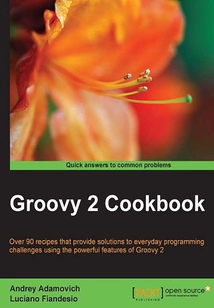舉報 

會員
Groovy 2 Cookbook
最新章節:
Index
ThisbookfollowsaCookbookstyleandispackedwithintermediateandadvancedlevelrecipes.ThisbookisforJavadeveloperswhohaveaninterestindiscoveringnewwaystoquicklygetthejobdoneusinganewlanguagethatsharesmanysimilaritieswithJava.Thebook’srecipesstartsimple,thereforenopreviousGroovyexperienceisrequiredtounderstandthecodeandtheexplanationsaccompanyingtheexamples.
目錄(122章)
倒序
- 封面
- 版權信息
- Credits
- About the Authors
- About the Reviewers
- www.PacktPub.com
- Preface
- Chapter 1. Getting Started with Groovy
- Introduction
- Installing Groovy on Windows
- Installing Groovy on Linux and OS X
- Executing Groovy code from the command line
- Using Groovy as a command-line text file editor
- Using Groovy to start a server on the command line
- Running Groovy with invokedynamic support
- Building Groovy from source
- Managing multiple Groovy installations on Linux
- Using groovysh to try out Groovy commands
- Starting groovyConsole to execute Groovy snippets
- Configuring Groovy in Eclipse
- Configuring Groovy in IntelliJ IDEA
- Chapter 2. Using Groovy Ecosystem
- Introduction
- Using Java classes from Groovy
- Embedding Groovy into Java
- Compiling Groovy code
- Simplifying dependency management with Grape
- Integrating Groovy into the build process using Ant
- Integrating Groovy into the build process using Maven
- Integrating Groovy into the build process using Gradle
- Generating documentation for Groovy code
- Checking Groovy code's quality with CodeNarc
- Chapter 3. Using Groovy Language Features
- Introduction
- Searching strings with regular expressions
- Writing less verbose Java Beans with Groovy Beans
- Inheriting constructors in Groovy classes
- Adding the cloning functionality to Groovy Beans
- Defining code as data in Groovy
- Defining data structures as code in Groovy
- Implementing multiple inheritance in Groovy
- Adding a functionality to the existing Java/Groovy classes
- Defining type-checking rules for dynamic code
- Adding automatic logging to Groovy classes
- Chapter 4. Working with Files in Groovy
- Introduction
- Reading from a file
- Reading a text file line by line
- Processing every word in a text file
- Writing to a file
- Replacing tabs with spaces in a text file
- Filtering a text file's content
- Deleting a file or directory
- Walking through a directory recursively
- Searching for files
- Changing file attributes on Windows
- Reading data from a ZIP file
- Reading an Excel file
- Extracting data from a PDF
- Chapter 5. Working with XML in Groovy
- Introduction
- Reading XML using XmlSlurper
- Reading XML using XmlParser
- Reading XML content with namespaces
- Searching in XML with GPath
- Searching in XML with XPath
- Constructing XML content
- Modifying XML content
- Sorting XML nodes
- Serializing Groovy Beans to XML
- Chapter 6. Working with JSON in Groovy
- Introduction
- Parsing JSON messages with JsonSlurper
- Constructing JSON messages with JsonBuilder
- Modifying JSON messages
- Validating JSON messages
- Converting JSON message to XML
- Converting JSON message to Groovy Bean
- Using JSON to configure your scripts
- Chapter 7. Working with Databases in Groovy
- Introduction
- Creating a database table
- Connecting to an SQL database
- Querying an SQL database
- Modifying data in an SQL database
- Calling a stored procedure
- Reading BLOB/CLOB from a database
- Building a simple ORM framework
- Using Groovy to access Redis
- Using Groovy to access MongoDB
- Using Groovy to access Apache Cassandra
- Chapter 8. Working with Web Services in Groovy
- Introduction
- Downloading content from the Internet
- Executing an HTTP GET request
- Executing an HTTP POST request
- Constructing and modifying complex URLs
- Issuing a REST request and parsing a response
- Issuing a SOAP request and parsing a response
- Consuming RSS and Atom feeds
- Using basic authentication for web service security
- Using OAuth for web service security
- Chapter 9. Metaprogramming and DSLs in Groovy
- Introduction
- Querying methods and properties
- Dynamically extending classes with new methods
- Overriding methods dynamically
- Adding performance logging to methods
- Adding a caching functionality around methods
- Adding transparent imports to a script
- DSL for executing commands over SSH
- DSL for generating reports from logfiles
- Chapter 10. Concurrent Programming in Groovy
- Introduction
- Processing collections concurrently
- Downloading files concurrently
- Splitting a large task into smaller parallel jobs
- Running tasks in parallel and asynchronously
- Using actors to build message-based concurrency
- Using STM to atomically update fields
- Using dataflow variables for lazy evaluation
- Index 更新時間:2021-07-23 15:57:40
推薦閱讀
- Advanced Quantitative Finance with C++
- Docker and Kubernetes for Java Developers
- Java完全自學教程
- Visual Basic 6.0程序設計計算機組裝與維修
- Python Deep Learning
- 深入淺出Windows API程序設計:編程基礎篇
- Blender 3D Incredible Machines
- Functional Kotlin
- concrete5 Cookbook
- JAVA程序設計實驗教程
- 高級語言程序設計(C語言版):基于計算思維能力培養
- Oracle 18c 必須掌握的新特性:管理與實戰
- 深入理解Elasticsearch(原書第3版)
- 零基礎趣學C語言
- 從Excel到Python數據分析:Pandas、xlwings、openpyxl、Matplotlib的交互與應用
- PHP+MySQL動態網站開發從入門到精通(視頻教學版)
- Implementing Domain:Specific Languages with Xtext and Xtend
- Java網絡編程實用精解
- 梔子貓的奇幻編程之旅:21天探索信息學奧賽C++編程
- Spark Streaming技術內幕及源碼剖析
- Drupal 8 Quick Start Guide
- Mastering iOS Game Development
- Getting Started with Zurb Foundation 4
- 強化學習:原理與Python實現
- 數據結構編程實驗(第3版)
- Java+OpenCV高效入門
- 大學計算機基礎
- Learning Linux Shell Scripting
- Bash Cookbook
- Spring Cloud Alibaba 微服務原理與實戰

